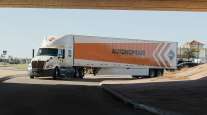Navistar Posts 3Q Profits, Cites Supplier Problems
This story appears in the Sept. 12 print edition of Transport Topics.
Truck maker Navistar International Corp. reported a jump in quarterly profits boosted mainly by a tax-related adjustment and said its sales have accelerated but are still held back by problems with components suppliers.
In a complicated financial report for its fiscal third quarter ended July 31, Navistar boosted net income to $1.41 billion, or $18.24 a share, compared with $129 million, or $1.56 a share, last year.
Revenue in the third quarter this year climbed to $3.54 billion from $3.22 billion a year ago, but the bottom line was driven by a one-time noncash, balance sheet adjustment for income tax arrangements worth $1.46 billion.
Navistar’s truck division lost $75 million even as revenue grew to $2.46 billion, but that was due to $130 million in more one-time charges for closing its factory in Chatham, Ontario, and restructuring engineering facilities.
Daniel Ustian, Navistar chairman and CEO, told stock analysts that “The trend in the industry has been for the last three years very difficult, but encouraging going into 2011 . . . and that trend for improvement should stay with us for quite some time now.”
Navistar still expects the U.S. economy to grow 2.4% this year, even though the gross domestic product rate grew at just a 0.7% annual rate in the first six months.
Ustian said Navistar worldwide truck sales have accelerated during the first nine months of the company’s fiscal year, and he expects the final quarter, which ends Oct. 31, to be the best yet, although the company will have to overcome supply problems affecting the entire truck-making industry.
Tier 2 and 3 suppliers — “not our suppliers, but our suppliers’ suppliers” — have been struggling to keep up with demand, Ustian said. More than the ab-solute quantity they can produce, he said, it has been a question of timeliness.
Ideally, Navistar wants to run a given vehicle down an assembly line just once. Instead, the company has been building nearly complete trucks and then “finishing them offline” in many cases. Ustian said this has been more of a problem on Class 8 production than on Classes 6 and 7 medium-duty vehicles.
However, Ustian said the problem appears to be abating. “It’s better now than it was six weeks ago,” he said, adding that it could clear over the next two or three months.
Navistar’s worldwide truck shipments rose to 28,900 for the quarter from 20,600 in last year’s May-to-July period, the report said. Another hindrance to profitability, though, is the composition of who is buying.
“There is more fleet buy and less dealer buy, which means this will stress pricing,” Ustian said. Dealers tend to sell off their lots to small-scale buyers, who tend to pay more per truck. Ustian said the price differential in such sales can be as much as 10%.
However, he said small purchasers have not completely left the market in that some of them appear to be leasing or renting trucks rather than buying them (8-29, p. 1).
In other aspects of the corporation’s business, Ustian said Latin American sales are doing well, particularly in Brazil. In contrast, military sales fell to $340 million in the recent quarter from $834 million, year-over-year, but he anticipated a rebound in the current quarter.
Commodity prices have stabilized at a high level, Ustian said, adding that trucks are currently priced accordingly with the price of inputs.
To reconcile the disparate effects of various accounting issues for its financial statement, Navistar offered adjusted profit figures in its Sept. 7 report, scrubbing one-time charges from the current and year-ago quarters. That approach yielded a decline in net income to $61 million, or 79 cents a share, from $107 million, or $1.44 a share.
Navistar customers are doing better, as the past-due percentage on finance division loans and the loss percentage have both declined significantly year-over-year.




